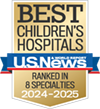Preventing infections in the surgical site is a part of patient safety. Our goal is to keep these infections to a minimum.
Why this matters
A surgical site infection (SSI) is an infection that a patient can get after an operation while in the hospital. These infections can occur on the surface of the skin at the incision site or deeper. If this happens, patients may get sicker or have to stay in the hospital longer. While some patients may be at a higher risk for a surgical site infection, many of these infections may be preventable.
How we measure
While any surgery may put a patient at risk for an infection, we currently measure a few specific types of surgeries including heart, spine (spinal fusion) and brain (craniotomy/vp shunt) surgeries. We measure the number of patients who developed an infection at the surgical wound site within 30 days following surgery or within one year if the infection involves an implantable device.
A “rate” is calculated by counting the number of surgical site infections (SSI’s) for every 100 patients who had a surgical procedure.
We look at two types of infections:
- A Class I surgical site is a clean wound. This means there is no infection or inflammation. The respiratory, alimentary (digestive tract), genital or uninfected urinary tract would not be entered as part of the surgical procedure.
- A Class II surgical incision site is a clean-contaminated wound. This is a wound in which the respiratory, alimentary (digestive tract), genital, or urinary tracts are entered under controlled conditions and without unusual contamination.
What we are doing to reduce surgical site infection rates
- We are working with other children's hospitals to establish best practices.
- Our prevention strategies address the timing, selection, and duration of antibiotics given before, during, and after the surgical procedure, as well as, appropriate cleansing to reduce skin bacteria before and after the surgery.
- We follow the best practices recommended by the Centers for Disease Control and Prevention (CDC) and CHSPS.



